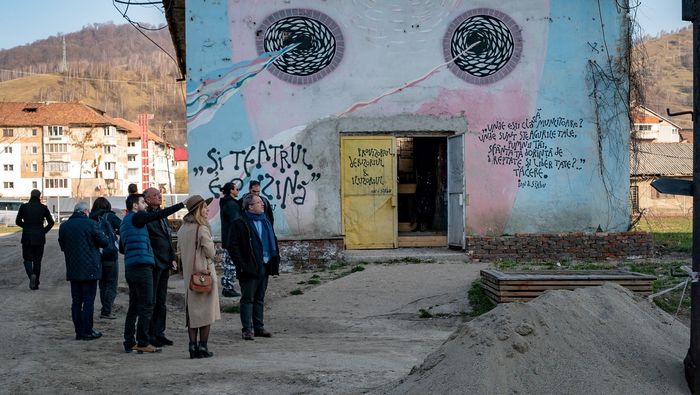Tourism is one of the most carbon-intensive sectors in the world. According to a study from 2018 each dollar a tourist spends induces one kilo of carbon dioxide equivalents – this is 25 percent more than the average of other sectors. However, there are industries being even more destructive to the climate. Coal mining is one of them. While for a long time it was a motor for the economic growth, coal is becoming more and more uneconomic. Many countries are taking the chance for a transition – just like Romania that gives the old coal fields in Jiu Valley a new economic significance through tourism.
Hospitality: New hope for the Jiu Valley
Coal mining was once a thriving industry in Romania, getting almost a million people into employment. In the 90ies, around 80 percent of the workforce in the Jiu Valley depended upon the mines. When a World Bank programme closed unprofitable mines in 1997, the coal center of Romania has been hit hard. The impact of unemployment has been considerable as new work opportunities for laid-off miners and their families were rare. Despite eleven of the original fifteen mines were closed, the Jiu Valley remained mono-industrial, with many jobs still linked to mining and power generation from the coal value chain. The global demand for coal is rapidly declining, putting pressure on the region to find viable new options for economic development. To overcome its dependence on coal, the government is planning to transform the area into a tourism site. Local heritage, healthy and sustainable life quality as well as the natural beauty of the region are supposed to be the cornerstones of the future development in Jiu Valley. Tourism and infrastructure development therefore must go hand in hand with preserving the environment.
Offsetting the declining coal sector: Diversification is the key
Several projects have explored the viability of new value chains, such as tourism to diversify the Jiu Valley economy. There are many types of touristic activities planned such as skiing, hiking, and biking in the mountains surrounding the area, post-industrial cultural tourism to visit former mines and industrial infrastructures, ethnographic tourism to visit the rural parts of the valley, but also eco-tourism in the nearby protected areas. According to Dan Dobre from Bankwatch Romania, many residents, especially former coal workers, like the idea to turn Jiu Valley into a tourist attraction: “Coal mining in Jiu Valley is in decline since the 90s. People don’t really put too much hope in mining as a viable economic activity, most of them are reorienting towards other domains, some of them leaving the country to find a job. Tourism seems for most of the residents of the region the most attractive option. I agree that tourism is a viable solution, but the government has to make sure that the region is diversifying and doesn’t put all its eggs in one basket.”
Bottom-up approach for sustainable local development
It seems like the region has learned from its painful past when mines were closed with no further plans for economic transition. An association of local stakeholders was created to identify new opportunities for existing or emerging sectors that can serve as drivers of growth. An official coalition of local actors called ‘Jiu Valley Involved’ has already developed some interesting projects in the region. For example, the grassroots organisation Planeta Petrila saved and reconverted the mining heritage of Romania’s oldest coal mine: the Petrila mine, which opened in 1858. The Noi Orizonturi Foundation revived an old mountain bike route and built a world-class biking trail in Jiu Valley. Though trade unions were suspicious of the intentions of grassroot activists, they had the common desire of a strategic transition for the sake of the region. “What in 2012 was an industrial site on the verge of demolition is now a site in the process of bottom-up urban regeneration. Although we encountered administrative difficulties, we’re now carrying out the first procedures for the restoration of the mining complex itself,” explains Mihai Danciu, an environmental activist in Jiu Valley.
Just transition in progress
As committed and inventive as they are, the transition cannot rely solely on NGO projects. “The people in Jiu Valley need jobs they can make a living with. To achieve this, investments in business infrastructure are indispensable,” says Dobre. Job creation in tourism might be a promising option in coal-dependent regions. However, Danciu observes mixed feeling: “Some are happy about this future, but it is mainly those that already benefit from tourist activities. Others are reluctant because the plans by the government are insufficient to ensure sustainable development in the region and provide economic opportunities for more than 100,000 residents. The hospitality industry only accounts for three or four percent of the local economy. Therefore, tourism cannot replace the whole coal industry. Actually, it mainly benefits the richest or most influential people in the area.” One reason for this is that the coal value chain is characterised by a relatively high reliance on semi- and low-skilled workers. Even if jobs in tourism are created in Jiu Valley, those will not necessarily benefit affected workers and communities. To guarantee a just transition, programms are needed to reskill workers, to improve the competitiveness of services and connectivity of the area, to strengthen administrative capacity and stimulate collaboration between local actors.
Tourism surely has the potential to contribute to a just transition in terms of new economic paths. But it is not a surefire way of fostering long-lasting development. The new tourism products in the region must provide a real low-carbon alternative in comparison to the coal mining to contribute to a sustainable development. And it must address the sector’s vulnerability against the effects of climate change. Otherwise, investments in ski slopes or other infrastructure might be unprofitable sooner than expected – just like the coal mines in the 90ies.




